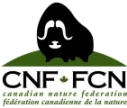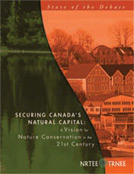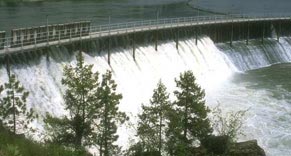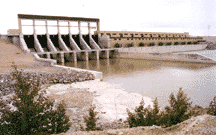
News |
- Protected Areas Since 1999 - Audit Released
- RIO Report Card: Sierra Club Canada
- Time to Conserve Canada's Boreal Forest
- NRTEE Releases "Securing Canada's National Capital" Report
- Manitoba Falters in Protected Areas Establishment - Again
- Politicians Support Protected Areas
- Climate Change Could Disrupt Wuskwatim Project
- Manitoba Hydro Ordered to Lower Rates
- WWF Canada Releases Nature Audit
- CNF Sends Political Parties 2003 Election Survey
- Protected Areas Before Hydro Development - CNF
- Consultation for Planning Act Amendments Flawed
Protected Areas Since 1999 - Audit Released |
13 June 2003 | ||
 The Canadian Nature Federation (CNF) released its audit of Manitoba protected areas and parks decisions since 1999 in Winnipeg May 1, 2003. The audit was conducted to verify a statement in the November 2002 Speech from the Throne: "Since 1999 close to a million hectares has been added to protected areas and parklands in Manitoba". The Canadian Nature Federation (CNF) released its audit of Manitoba protected areas and parks decisions since 1999 in Winnipeg May 1, 2003. The audit was conducted to verify a statement in the November 2002 Speech from the Throne: "Since 1999 close to a million hectares has been added to protected areas and parklands in Manitoba".The protected areas audit, conducted by the Manitoba Wildlands office of the CNF, determined that in fact new protected areas established in Manitoba since fall 1999 total 194,957 Ha. (See statistic summary below.) Gaile Whelan Enns, Manitoba Wildlands Director for the CNF said the Manitoba government needs to resume establishing new protected areas, especially in our forest natural regions. "Minister Ashton has extended Manitoba's Action Plan and he indicated this week that his department will 'strive to create a network of core protected areas.' " "Manitobans are waiting for that to happen – and they expect significant decisions for new protected areas throughout our province this year. These recent commitments must be acted on" Gaile Whelan Enns said. View the 1999 - 2003 Protected Areas stats summary, Updated June 13, 2003 Read the 1999 Election Promises Read the 2003 Election Promises For more detailed information go to our Protected Areas page
|
|||
RIO Report Card: Sierra Club Canada |
26 June 2003 |
 The Sierra Club of Canada, an independent environmental organization, released its eleventh annual RIO Report Card June 25. The Report Card was initially a product of the Rio Watch Project launched after the 1992 Earth Summit in Rio de Janeiro. This year the RIO Report Card was renamed the Report on International Obligations (RIO). The research and data used for the report was gathered in conjunction with thirty other no-government organizations. The Sierra Club of Canada, an independent environmental organization, released its eleventh annual RIO Report Card June 25. The Report Card was initially a product of the Rio Watch Project launched after the 1992 Earth Summit in Rio de Janeiro. This year the RIO Report Card was renamed the Report on International Obligations (RIO). The research and data used for the report was gathered in conjunction with thirty other no-government organizations.
"We have been known as tough graders, and this year was no exception," noted Executive Director Elizabeth May. "But in a year when Canada ratified Kyoto and the Prime Minister made commitments for ten new national parks, the federal grades made a significant jump." The federal grade on climate change was broken in two, with an "A" for ratification of Kyoto and an "incomplete" on implementation. Some provinces made impressive gains. The top provincial marks this year went to the former Quebec government of Bernard Landry. After years of neglect, the province finally began protecting wilderness, moving from a "D" to a "B" on biodiversity, while being graded the highest provincial mark in climate change. Despite an election, Manitoba's performance on biodiversity did not improve, although the province did improve its climate change grade. All eleven years of the RIO Report Card, with reports for each province and territory, can be found on the Sierra Club of Canada website: www.sierraclub.ca. |
|
Time to Conserve Canada's Boreal Forest |
24 June 2003 |
 Time is running out for Canada to conserve one of the world's largest remaining intact forest ecosystems. A June 1999 Canadian Senate report called for action to conserve Canada's boreal forest because it is "increasingly under siege". But a review of progress since then shows that the major thrust of the Senate recommendations have not been acted upon, even though pressure to develop the remaining intact portions of Canada's boreal forest continues to grow. Time is running out for Canada to conserve one of the world's largest remaining intact forest ecosystems. A June 1999 Canadian Senate report called for action to conserve Canada's boreal forest because it is "increasingly under siege". But a review of progress since then shows that the major thrust of the Senate recommendations have not been acted upon, even though pressure to develop the remaining intact portions of Canada's boreal forest continues to grow.
The Boreal Forest at Risk: A Progress Report was released June 23, 2003 by the Canadian Boreal Initiative (CBI), established earlier this year to promote better scientific understanding, conservation and management of Canada's vast boreal forest ecosystem. "Canada has one of the few remaining opportunities to conserve what amounts to one-quarter of the world's remaining large forests. While it's not too late to move on the Senate report's recommendations, if governments don't act now, the fate of Canada's boreal region will be determined on a piece meal basis," says Cathy Wilkinson, Director of the CBI. There are both short-term and long-term concrete actions that governments can take to conserve Canada's boreal forest. Examples of immediate action that governments can take to follow up on the Senate report include completing the network of representative protected areas across Canada that was promised by 2000. The recent World Wildlife Fund Nature Audit estimates that less than half of this network is in place. Governments should also move immediately to address their obligations regarding land and Aboriginal peoples, and to improve monitoring of wildlife species. Summary and full report available at www.borealcanada.ca |
|
NRTEE Releases "Securing Canada's National Capital" Report |
19 June 2003 |
 A report released June 16, 2003, by the National Round Table on the Environment and the Economy (NRTEE), calls for Canada to become a global leader in nature conservation by taking innovative and decisive actions to maintain the diversity and health of our unparalleled natural ecosystems. A report released June 16, 2003, by the National Round Table on the Environment and the Economy (NRTEE), calls for Canada to become a global leader in nature conservation by taking innovative and decisive actions to maintain the diversity and health of our unparalleled natural ecosystems.The report, entitled "Securing Canada's National Capital: A Vision for Nature Conservation in the 21st Century" notes the importance of protected areas as anchors in a conservation system. The report also promotes the conservation of natural capital on working landscapes where agricultural, logging and mining industries operate in order to adequately conserve stocks of natural capital. Also critical to conservation efforts is responding to the needs of local communities and Aboriginal peoples. The report states that conservation strategies must emphasize the role of local communities and Aboriginal peoples as stewards of nature, and work to ensure that nature conservation brings them social and economic benefits. "A long-term conservation strategy will only work if local communities buy in and support it. There is an indispensable role that the people of our rural communities could – and indeed must – play if we are to conserve natural capital, thus preserving the economic options of future generations," said David J. McGuinty, President and CEO of the Round Table. View the report, executive summary, and news release View Manitoba protected areas information |
|
Manitoba Falters in Protected Areas Establishment - Again |
29 May 2003 |
 The annual Manitoba protected areas grade was released in Winnipeg May 29, 2003 by the Manitoba Wildlands Campaign office, Canadian Nature Federation. The annual Manitoba protected areas grade was released in Winnipeg May 29, 2003 by the Manitoba Wildlands Campaign office, Canadian Nature Federation.The low grade of D- was the result of the province's lack of action over the last year. No new protected areas have been established in the province since 2001. "Recent polling reveals that 91% of Manitobans support action to establish new protected areas in our province," said Gaile Whelan Enns, Manitoba Director, Wildlands Campaign, Canadian Nature Federation. "Manitobans want to see action to protect our natural heritage start on June 4 — the day after the current election!" View the 2003 CNF protected areas grade View the 2003 CNF protected areas grade and technical assessment View Manitoba protected areas information, government commitments, previous protected areas grades (10 year chart), and CNF election survey |
|
Politicians Support Protected Areas |
23 May 2003 |
 As of May 23, 2003 all four political parties active in Manitoba's provincial election have responded to the Canadian Nature Federation Protected Areas election survey. (Election day is June 3, 2003.) Questions focused on four policy areas: new protected area establishment, climate change, Manitoba Hydro, and Manitoba's east side land use planning initiative. Survey questions are about actions/policies of all parties, should they form government, following the current election. As of May 23, 2003 all four political parties active in Manitoba's provincial election have responded to the Canadian Nature Federation Protected Areas election survey. (Election day is June 3, 2003.) Questions focused on four policy areas: new protected area establishment, climate change, Manitoba Hydro, and Manitoba's east side land use planning initiative. Survey questions are about actions/policies of all parties, should they form government, following the current election.The survey results indicate that all four parties support new protected areas establishment. The NDP response reconfirms their various 1999 election environmental commitments. "All political parties fully support getting on with establishing new protected areas in Manitoba. This means they agree with 91% of Manitobans who supported new protected areas establishment in a recent poll," said Gaile Whelan Enns, Manitoba Director, Wildlands Campaign, Canadian Nature Federation. View the CNF election survey View the CNF election survey results |
|
Climate Change Could Disrupt Wuskwatim Project |
19 June 2003 |
 According to a Manitoba Government water expert, Manitoba Hydro's plans to expand Manitoba's hydroelectric generation capacity could be disrupted by water shortages due to global warming. According to a Manitoba Government water expert, Manitoba Hydro's plans to expand Manitoba's hydroelectric generation capacity could be disrupted by water shortages due to global warming. Alf Warkentin, Manitoba Conservation Senior Hydrologic Forecaster, says climate change is already causing water shortages. Manitoba's lakes are at their lowest levels in 20 years. For instance:
Manitoba Hydro is planning to build the 200 MW Wuskwatim Generation and Transmission projects with an in-service date as early as 2009. The projects are currently under Environmental Impact Statements review, with environmental licensing hearings expected later in 2003. View the May 15, 2003 Manitoba Lakes Report For information on Manitoba Hydro intentions see our Energy Development in Manitoba page Source: CBC June 18, 2003 |
|
Manitoba Hydro Ordered to Lower Rates |
February 2003 |
 Manitoba Hydro is appealing the February 2003 Public Utilities Board (PUB) Order (board order 7/03). The Order requires the public utility to decrease electrical rates and to file a number of studies prior to December 31, 2003. Manitoba Hydro is appealing the February 2003 Public Utilities Board (PUB) Order (board order 7/03). The Order requires the public utility to decrease electrical rates and to file a number of studies prior to December 31, 2003. Manitoba Hydro seeks to reverse the decision on rates and requests up to a year to complete certain studies (including a feasibility study on wind power and a study on inverted rates to promote energy conservation). Currently licensing steps are underway for the first of several new Manitoba Hydro developments. Manitoba Hydro appeared before the PUB in May-June 2002 as part of a mandatory Status Update. The February 2003 PUB report included orders (binding) and a number of recommendations (non-binding). The appeal documents include a 10-year financial forecast that projects rate increases of 20%. All documents can be viewed at the board's on-site library. The Manitoba PUB does not have a website. Manitoba Hydro is a publicly owned utility that provides electricity and distributes natural gas to the province of Manitoba. The PUB operates under the authority of the Manitoba legislature and regulates Manitoba public utilities. For more information go to: Energy Development in Manitoba |
|
WWF Canada Releases Nature Audit |
May 2003 |
 World Wildlife Fund Canada (WWF-Canada) released a groundbreaking report that audits the state of Canada's efforts to conserve biodiversity in Toronto May 26, 2003. In doing so, the organization has identified an urgent and growing nation-wide need to protect, manage and restore the nation's natural capital. World Wildlife Fund Canada (WWF-Canada) released a groundbreaking report that audits the state of Canada's efforts to conserve biodiversity in Toronto May 26, 2003. In doing so, the organization has identified an urgent and growing nation-wide need to protect, manage and restore the nation's natural capital. “The Nature Audit reveals that many Canadian species and habitats are declining,” says WWF-Canada President Monte Hummel. “To use a financial analogy, we're not protecting our savings, we're not spending wisely enough, and we're badly overspent in some parts of the country. That is having a real and measurable impact on nature's bottom line.” The Nature Audit graphically illustrates the extent of this human footprint and presents a regional look at how it is impacting the state of Canadian biodiversity. “WWF-Canada has assumed the role of an independent watchdog to measure how well Canada is fulfilling its commitments to conserve biodiversity and to protect its natural capital,” says Kevin Kavaagh, Biodiversity Conservation Reporting Director. View the entire WWF report and summaries |
|
CNF Sends Political Parties 2003 Election Survey |
12 May 2003 |
 The Canadian Nature Federation (CNF) sent all four Manitoba political parties its election survey regarding their commitments to protected areas and the environment today. The Canadian Nature Federation (CNF) sent all four Manitoba political parties its election survey regarding their commitments to protected areas and the environment today.The political parties have been given one week to respond to these questions and to add their additional environmental promises. The survey also requests confirmation from the New Democratic Party of the environment and protected areas commitments made during the 1999 election. The definition of a protected area in Manitoba's Action Plan for a Network of Protected Areas is an area that is “closed by legal means to logging, mining, hydroelectric development or any other activity that significantly affects habitat.” View the 2003 Manitoba Election Survey |
|
Protected Areas Before Hydro Development - CNF |
April 2003 | ||
 "There are no new protected areas in Manitoba's boreal forest regions," Manitoba Wildlands Campaign director for the Canadian Nature Federation, Gaile Whelan Enns, confirmed mid April 2003. "There are no new protected areas in Manitoba's boreal forest regions," Manitoba Wildlands Campaign director for the Canadian Nature Federation, Gaile Whelan Enns, confirmed mid April 2003."Significant areas under review for protection are simply stagnating while major Manitoba Hydro development intentions in these boreal regions are promoted. It is time to secure these conservation decisions before any new dams or transmission corridors are licensed. As a publicly owned utility Manitoba Hydro must support new protected areas - in the public interest and for the northern boreal forest environment, " said Whelan Enns. Manitoba Hydro and the Manitoba government are currently promoting at least 4 new dams and thousands of kilometers of transmission corridor in regions where there are no protected areas. These plans include inter-provincial transmission systems to provide energy to Ontario. For mapping of Manitoba protected areas and areas under review for protected area status go to our Protected Areas page. For Manitoba Hydro mapping to show current and future dam - transmission system locations go here
|
|||
Consultation for Planning Act Amendments Flawed |
May 2003 |
 The Manitoba office of the Canadian Nature Federation (CNF) asked the Manitoba government in spring 2003 to improve the public consultation process prior to amending The Planning Act. The Manitoba office of the Canadian Nature Federation (CNF) asked the Manitoba government in spring 2003 to improve the public consultation process prior to amending The Planning Act.The Manitoba Department of Intergovernmental Affairs (IA) initiated the process in December 2002 and expects it to be completed within 18 months. A discussion paper was released and six public workshops were held. A separate public consultation on improving the province's land use policies is expected to start as early as October 2003. Some of the main CNF recommendations include:
|
|


 RSS Feeds:
RSS Feeds:
